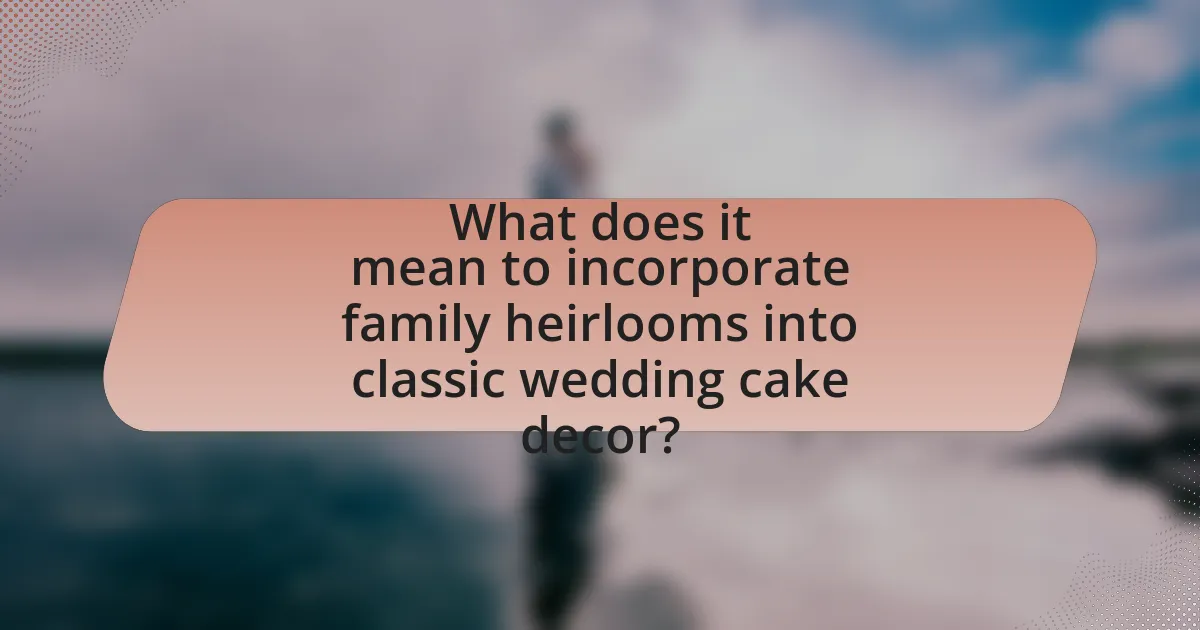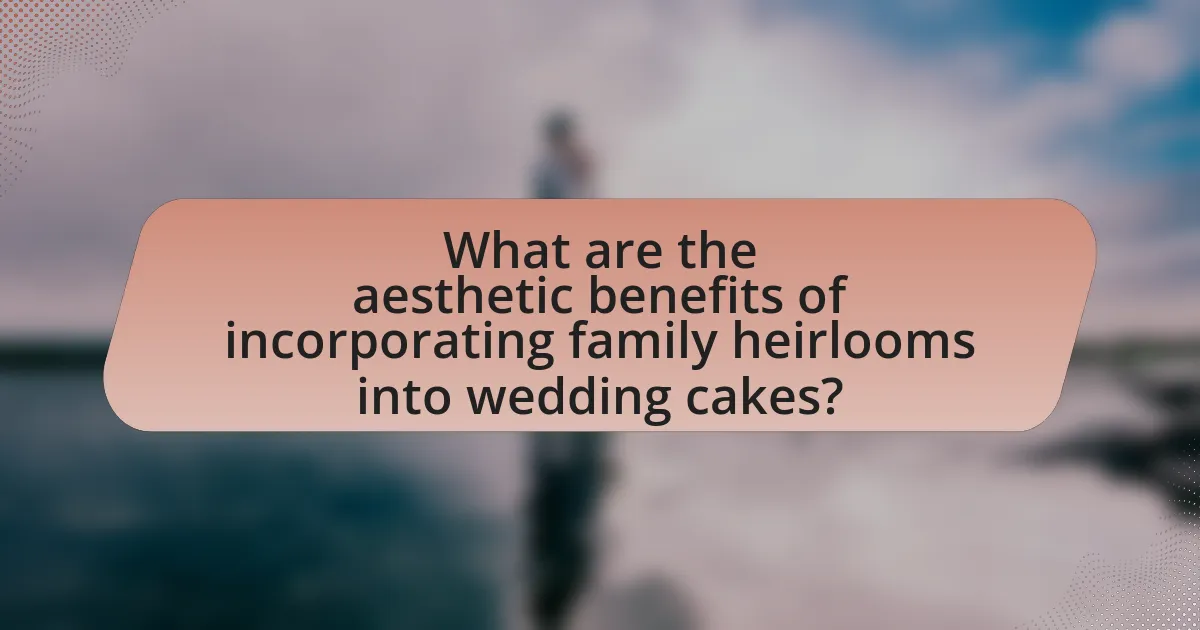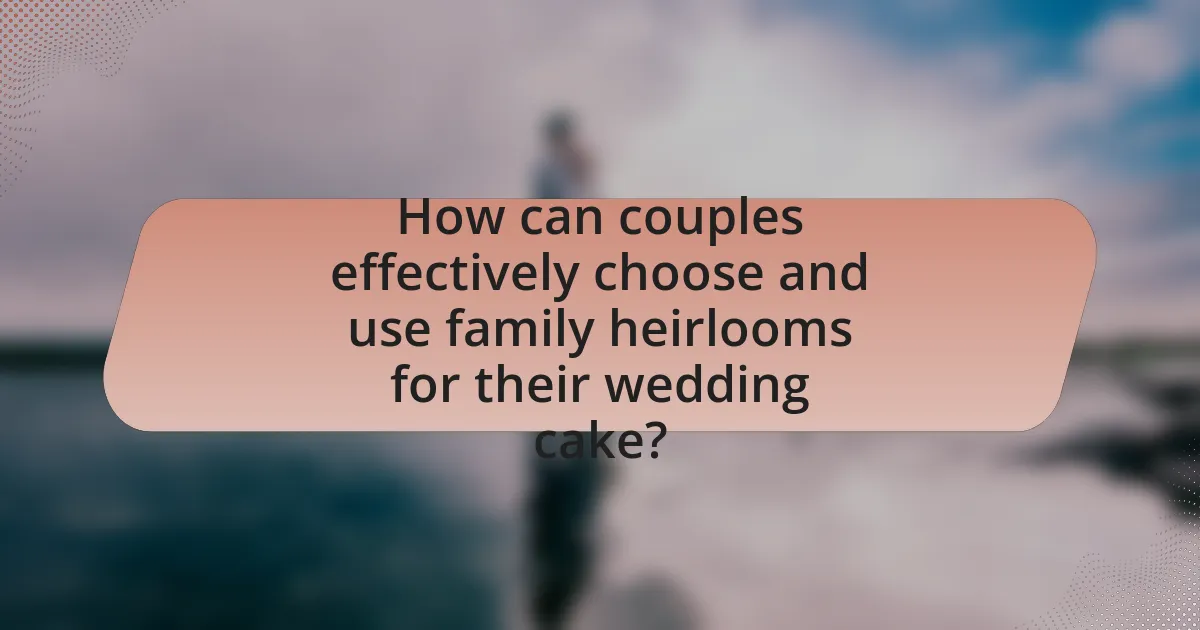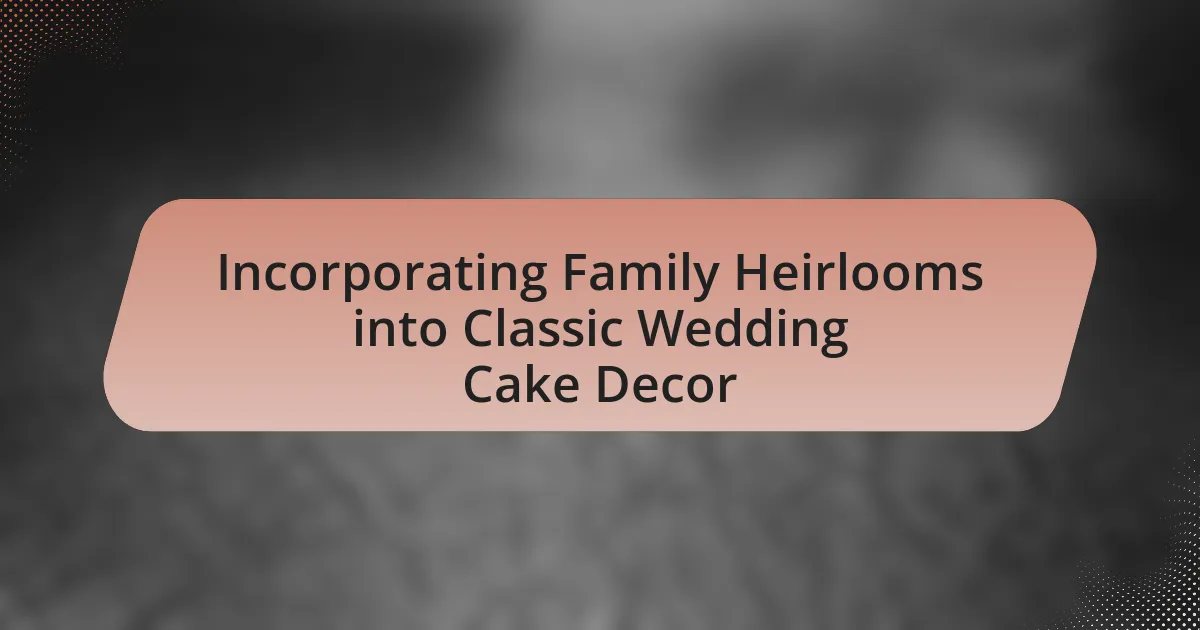Incorporating family heirlooms into classic wedding cake decor involves integrating meaningful items passed down through generations, enhancing the cake’s personal significance and emotional value. This practice symbolizes family heritage and continuity, with common heirlooms including vintage jewelry, lace, china, and photographs. The article explores the significance of these heirlooms in wedding traditions, creative ways to integrate them into cake designs, and best practices for ensuring their safe use. Additionally, it addresses potential challenges and offers practical tips for couples to effectively personalize their wedding cakes while honoring family legacies.

What does it mean to incorporate family heirlooms into classic wedding cake decor?
Incorporating family heirlooms into classic wedding cake decor means integrating meaningful items passed down through generations into the design of the wedding cake. This practice adds a personal touch and emotional significance to the cake, often symbolizing family heritage and continuity. For example, using a vintage cake topper or decorative elements from a family member’s wedding can evoke cherished memories and honor family traditions, making the cake not just a dessert but a representation of familial love and history.
Why are family heirlooms significant in wedding traditions?
Family heirlooms are significant in wedding traditions because they symbolize continuity, heritage, and familial bonds. These items often carry emotional weight and historical significance, representing the love and commitment of previous generations. For instance, a wedding ring passed down through generations not only serves as a token of love but also connects the couple to their family’s history and values. This connection enhances the meaning of the wedding ceremony, making it a celebration of both the couple’s union and their family’s legacy.
What types of family heirlooms are commonly used in wedding decor?
Common family heirlooms used in wedding decor include vintage jewelry, lace, china, and photographs. Vintage jewelry, such as brooches or necklaces, can be incorporated into floral arrangements or worn by the bride, adding sentimental value. Lace from family wedding dresses can be used to adorn table settings or as part of the cake design, creating a personal touch. China sets passed down through generations can serve as unique serving dishes or decorative elements on tables. Additionally, photographs of ancestors can be displayed to honor family history, enhancing the emotional significance of the event. These heirlooms not only personalize the decor but also connect the couple to their family legacy.
How do family heirlooms enhance the emotional value of a wedding cake?
Family heirlooms enhance the emotional value of a wedding cake by creating a deep personal connection to family history and traditions. When couples incorporate heirlooms, such as a decorative cake topper or serving set passed down through generations, they evoke memories and sentiments associated with their family’s love and commitment. This practice not only honors past relationships but also symbolizes the continuity of family bonds, making the wedding cake a centerpiece that reflects shared heritage. Studies show that objects with personal significance can increase emotional attachment, reinforcing the idea that family heirlooms contribute to the overall sentimental experience of the wedding celebration.
How can family heirlooms be integrated into classic wedding cake designs?
Family heirlooms can be integrated into classic wedding cake designs by using them as decorative elements or cake toppers. For example, a vintage cake topper from a family wedding can be placed atop the cake, adding a personal touch and historical significance. Additionally, heirloom jewelry, such as brooches or charms, can be incorporated into the cake’s design, either embedded in the frosting or used as embellishments on the cake layers. This practice not only honors family traditions but also creates a unique aesthetic that reflects the couple’s heritage.
What are some creative ways to display heirlooms on a wedding cake?
Creative ways to display heirlooms on a wedding cake include using decorative cake toppers, incorporating heirloom jewelry into the design, and utilizing edible prints of family photos. Decorative cake toppers can be custom-made to feature significant family symbols or items, such as a vintage brooch or a small family crest, which adds a personal touch. Heirloom jewelry, like a grandmother’s ring or a locket, can be elegantly placed on the cake or used as part of the cake’s decoration, enhancing its sentimental value. Edible prints of family photos can be applied to the cake’s surface, allowing for a visual representation of family history that is both creative and meaningful. These methods not only personalize the cake but also honor family traditions and memories.
How can bakers ensure heirlooms are safely incorporated into cake decor?
Bakers can ensure heirlooms are safely incorporated into cake decor by using food-safe materials and techniques. This includes wrapping heirlooms in food-safe plastic or using decorative elements that are specifically designed for food contact, such as silicone molds or edible glues. Additionally, bakers should avoid placing heirlooms directly on the cake to prevent contamination and instead use stands or supports that keep the heirlooms elevated and separate from the cake itself. This approach minimizes the risk of foodborne illness while allowing the heirlooms to be showcased effectively.
What challenges might arise when using family heirlooms in wedding cake decor?
Using family heirlooms in wedding cake decor can present several challenges, including potential damage to the heirlooms, difficulty in ensuring food safety, and the need for careful integration with the cake’s design. Damage can occur if the heirlooms are fragile or not designed for food contact, which may lead to loss of sentimental value. Food safety concerns arise if heirlooms are not properly sanitized or if they contain materials that could contaminate the cake. Additionally, achieving a cohesive aesthetic can be challenging, as the heirlooms must complement the overall theme and style of the wedding cake without overwhelming it.
How can couples address potential damage to heirlooms during the wedding?
Couples can address potential damage to heirlooms during the wedding by implementing protective measures such as using display cases or protective coverings. These methods ensure that heirlooms, which may include delicate items like vintage cake toppers or family china, are shielded from spills, falls, or accidental contact. For instance, placing heirlooms in glass display cases not only preserves their condition but also allows guests to appreciate their significance without direct handling. Additionally, couples can designate specific areas for heirlooms, minimizing the risk of them being misplaced or damaged amidst the wedding festivities.
What are the best practices for preserving heirlooms used in cake decor?
The best practices for preserving heirlooms used in cake decor include proper cleaning, careful storage, and regular maintenance. Cleaning should be done gently with mild soap and water to avoid damaging delicate materials. Heirlooms should be stored in a climate-controlled environment, away from direct sunlight and humidity, to prevent deterioration. Additionally, using acid-free materials for storage, such as tissue paper or boxes, helps protect heirlooms from dust and physical damage. Regular inspections for signs of wear or damage allow for timely repairs, ensuring the heirlooms remain in good condition for future use.

What are the aesthetic benefits of incorporating family heirlooms into wedding cakes?
Incorporating family heirlooms into wedding cakes enhances their aesthetic appeal by adding unique, personalized elements that reflect family history and tradition. These heirlooms, such as vintage cake toppers or decorative serving pieces, introduce distinctive textures, colors, and designs that can elevate the overall visual impact of the cake. For instance, a vintage topper may feature intricate craftsmanship that contrasts beautifully with modern cake designs, creating a striking focal point. Additionally, the emotional significance of these heirlooms can evoke nostalgia and warmth, making the cake not just a dessert but a meaningful centerpiece that tells a story. This blend of personal history and artistic expression contributes to a visually captivating and memorable wedding cake.
How do heirlooms contribute to the overall theme of a wedding?
Heirlooms contribute to the overall theme of a wedding by adding personal significance and a sense of continuity between generations. These cherished items often embody family history and traditions, which can enhance the emotional depth of the ceremony. For instance, incorporating a family heirloom, such as a vintage cake topper or serving set, not only personalizes the wedding decor but also symbolizes the couple’s connection to their families. This practice is supported by the fact that 70% of couples report that incorporating family traditions into their wedding enhances their experience, according to a survey by The Knot.
What visual elements do heirlooms add to classic wedding cake designs?
Heirlooms add intricate details, unique textures, and personalized motifs to classic wedding cake designs. These visual elements enhance the cake’s aesthetic by incorporating family history and sentimental value, often through decorative items like vintage cake toppers, ornate serving utensils, or lace from a family member’s wedding dress. For example, using a grandmother’s silver cake knife not only serves a functional purpose but also introduces a historical element that connects the couple to their lineage, making the cake visually distinctive and emotionally significant.
How can heirlooms reflect the couple’s personal story in their wedding cake?
Heirlooms can reflect the couple’s personal story in their wedding cake by incorporating meaningful family items or symbols that represent their heritage and shared experiences. For instance, a couple might use a vintage cake topper that belonged to a grandparent, symbolizing the continuity of love and tradition within their families. Additionally, elements such as specific colors or designs inspired by family heirlooms can evoke memories and values that are significant to the couple’s relationship. This personalization not only enhances the aesthetic of the cake but also tells a unique story that connects the couple to their past, making the celebration more meaningful.
What role do family heirlooms play in creating a unique wedding experience?
Family heirlooms play a significant role in creating a unique wedding experience by adding personal history and emotional depth to the celebration. These heirlooms, which often include items like jewelry, fabrics, or decorative pieces, serve as tangible connections to family traditions and stories, enriching the wedding’s narrative. For instance, incorporating a grandmother’s wedding dress or a family ring not only honors past generations but also creates a sense of continuity and belonging for the couple. This practice is supported by studies indicating that personal artifacts can enhance emotional engagement during significant life events, making the wedding more memorable and meaningful for both the couple and their guests.
How can heirlooms personalize the wedding cake for the couple?
Heirlooms can personalize the wedding cake for the couple by incorporating meaningful family items or symbols that reflect their heritage and shared history. For instance, using a vintage cake topper that belonged to a grandparent can evoke cherished memories and create a connection to family traditions. Additionally, edible decorations inspired by heirloom patterns or colors can further enhance the cake’s significance, making it a unique representation of the couple’s identity. This practice not only honors family legacies but also adds a personal touch that distinguishes the wedding cake from standard designs.
What memories can be evoked through the use of family heirlooms in cake decor?
Family heirlooms in cake decor can evoke cherished memories of family traditions, celebrations, and connections to ancestors. These heirlooms often carry significant emotional weight, reminding individuals of past family gatherings, such as weddings or anniversaries, where similar items were present. For example, a vintage cake topper may bring back memories of a grandparent’s wedding, reinforcing familial bonds and shared histories. Additionally, incorporating heirlooms can symbolize continuity and legacy, allowing individuals to honor their family’s past while creating new memories in the present.

How can couples effectively choose and use family heirlooms for their wedding cake?
Couples can effectively choose and use family heirlooms for their wedding cake by selecting items that hold sentimental value and can be integrated into the cake’s design. Heirlooms such as vintage cake toppers, decorative serving utensils, or even family recipes can enhance the cake’s personal significance. For instance, a couple might use a grandmother’s cake knife to cut the cake, symbolizing family tradition. Additionally, incorporating heirloom elements like lace from a family wedding dress as decoration can create a unique aesthetic while honoring family history. This approach not only personalizes the wedding cake but also connects the couple to their heritage, making the celebration more meaningful.
What factors should couples consider when selecting heirlooms for cake decor?
Couples should consider the sentimental value, aesthetic compatibility, and historical significance of heirlooms when selecting them for cake decor. Sentimental value ensures that the chosen items resonate emotionally, reflecting family traditions or memories. Aesthetic compatibility involves matching the heirlooms’ style and color with the overall wedding theme and cake design, ensuring a cohesive look. Historical significance adds depth to the decor, as items with a rich family history can enhance the narrative of the wedding. These factors collectively ensure that the heirlooms not only beautify the cake but also honor family heritage.
How can couples ensure the heirlooms align with their wedding theme?
Couples can ensure heirlooms align with their wedding theme by selecting pieces that reflect the overall aesthetic and color palette of the wedding. For instance, if the wedding theme is vintage, incorporating heirlooms such as lace doilies or antique cake toppers can enhance the decor. Additionally, couples should consider the materials and styles of the heirlooms; for example, using silver or crystal heirlooms can complement a formal or elegant theme. Historical context also supports this approach, as many couples have successfully integrated family heirlooms into their wedding decor, creating a cohesive look that honors family traditions while aligning with modern themes.
What is the best way to communicate the significance of heirlooms to guests?
The best way to communicate the significance of heirlooms to guests is through storytelling that highlights their history and emotional value. Sharing personal anecdotes about the heirlooms, such as who they belonged to and the memories associated with them, creates a deeper connection for guests. For example, explaining that a particular piece was passed down through generations during significant family events can illustrate its importance. This approach not only informs guests but also engages them emotionally, making the heirlooms more meaningful in the context of the wedding celebration.
What practical tips can help couples incorporate heirlooms into their wedding cake decor?
Couples can incorporate heirlooms into their wedding cake decor by using items such as vintage cake toppers, family jewelry, or decorative plates. For instance, a vintage cake topper can serve as a focal point, adding a personal touch that reflects family history. Additionally, incorporating family jewelry, like brooches or rings, can enhance the cake’s design while symbolizing love and commitment. Using decorative plates that have been passed down through generations can also create a unique presentation, showcasing the couple’s heritage. These methods not only personalize the cake but also honor family traditions, making the wedding celebration more meaningful.
How can couples work with bakers to achieve their vision for heirloom integration?
Couples can work with bakers to achieve their vision for heirloom integration by clearly communicating their ideas and providing specific examples of the heirlooms they wish to incorporate. This collaboration involves discussing the significance of the heirlooms, such as family traditions or specific items like jewelry or fabrics, which can inspire the cake’s design, flavor, or decoration. For instance, if a couple has a vintage lace tablecloth, they can ask the baker to replicate its pattern in fondant or use its color palette for the cake. Successful integration often relies on the baker’s experience and creativity, so couples should seek bakers who have a portfolio showcasing similar projects. This approach ensures that the final cake not only reflects the couple’s personal history but also aligns with their overall wedding theme.
What are some common mistakes to avoid when using heirlooms in cake decor?
Common mistakes to avoid when using heirlooms in cake decor include neglecting to clean the heirlooms properly, which can lead to contamination or damage to the cake. Additionally, using heirlooms that are not food-safe can pose health risks, as some materials may leach harmful substances. Another mistake is failing to consider the weight and stability of the heirlooms, which can cause structural issues with the cake. Lastly, not coordinating the heirloom’s design with the overall cake theme can result in a disjointed appearance. These mistakes can detract from the aesthetic and safety of the cake, making careful consideration essential.
